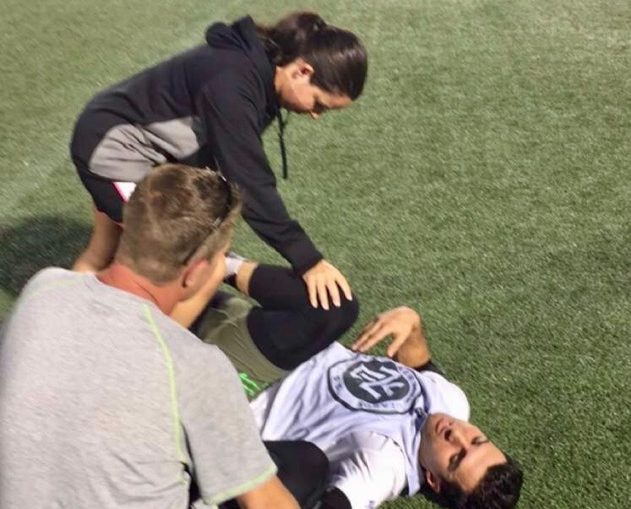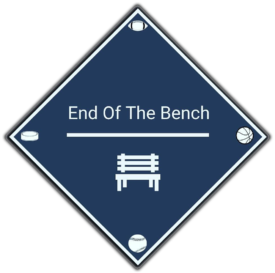
Everyone has their reasons or inspirations for gaining a vast interest in a subject. For me, the subject was sports and the reason was my older sister, Ali. Growing up, she was the one who taught me that there is always a game on and made sure that one was always on the TV. Other children were watching cartoons while I was busy watching ESPN. Besides being a great sister, the reason behind my interest in sports, my Yankee and Duke game partner, she is also my personal athletic trainer. I know what you guys are thinking, “Scott, you play slow pitch softball and you bowl, how do you need a personal athletic trainer?” Well, oddly enough that is what she tells me too! When I started The End of the Bench, I wanted to get my sister involved in some capacity; in order to achieve that, we sat down for a one-on-one interview, I hope you enjoy it!
Scott: Where do you currently work as an athletic trainer?
Ali: I am an athletic trainer at SUNY Old Westbury and for the professional lacrosse team, New York Lizards.
Scott: What made you decide to be an athletic trainer?
Ali: Well, I played sports all year round growing up and got hurt numerous times in the process. I dislocated my knee cap three times, twice in soccer and once in basketball, which landed me in physical therapy more often than most teenagers. That time in PT did spark an interest in possibly pursuing that career path, but I developed a good relationship with the Athletic Trainer at Calhoun High School which helped me realize that the athletic training field was more for me. What it came down to is that athletic training helps me stay closer to my passion of sports and enables the ability to have more personal relationship with my athletes. I don’t think I’m out of school to say there is no greater feeling for a physical therapist than when they realize their patient does not need them anymore; for me, the greatest feeling is when my athlete gets back onto the field or the court to do what they love and continue to pursue their passions.
S: I know when I tell people that you are an athletic trainer or when you tell people that you are an athletic trainer that they automatically equate that to PT. How are you different from a Physical Therapist?
A: To put it bluntly, the main difference is I am not a doctor. As an athletic trainer, my job is to assess, recognize, evaluate, and emergency management tasks; I am essentially a first responder to medical mishap that arises on the field or the court. Since I am not a doctor, I can not diagnose an injury. My responsibility is to recognize, assess, and evaluate an injury in order to provide the best guidance as possible to the team physician. Once the athlete goes to the team doctor, he would be the one to determine whether going to a physical therapist is necessary.
S: Athletics are widely viewed as a male dominant field; do you typically find it challenging being a woman in this field?
A: Statistically speaking, there are actually more female athletic trainers than male athletic trainers. Where the misconception comes from is that the athletic trainers for professional sports are mostly men. Being a woman in this field shares the same challenges that unfortunately all women go through in the work place. There is a constant pressure women feel to prove their worth, to prove their opinion is just as valid as the opinion of their male counterparts, and that they can do their job just as well, if not better than men. Luckily, I have worked with some tremendous coaches, fellow athletic trainers, and athletes that could care less if I am a woman or a fish; as long as I did my job effectively and continue to do so, I will gain their respect as a professional. It really is all about generating a level of respect and rapport with the people you work with on a daily basis.
S: What are your thoughts on the safety of football? Would you be able to be an athletic trainer for a football team now? I know that when you were working at Nassau Community College, you were exposed to football, but that was six years ago and our knowledge of CTE has soared to new heights in that short amount of time.
A: I would not want to work football. I think with the tackling and how it correlates to CTE, it all comes down to mechanics. If you tackle with your head up, you will alleviate some head and neck injuries, but even if you do all of that correctly, there is no guarantee it will completely help you be safe from head injuries. The last time I checked, it may be different now, I read that soccer players actually suffer from more concussions than football players. Which, when you think about it makes a little sense because the ball is hitting them directly in the head numerous times a game. However, concussions do not only happen if someone gets hit in the head. You can get hit almost anywhere in your upper body and get a concussion which makes football players the most susceptible to head injuries. Athletic trainers have a lot of what if moments when players re-injure body parts. “What could I have done to prevent this? Did I miss something in my evaluation? Did I not assess this properly” Now, with most sports, 9 times out of 10, those what if moments are not going to drastically alter an athlete’s life like it could if we do not recognize a concussion. Football or not, head injuries are rightfully so a major focus in my field.
S: What is your favorite sport to be assigned to?
A: It is definitely baseball. Despite it happening in the peak of allergy season, I love being in the dugout and being around the game of baseball. Some people say it’s slow and boring but for me it is perfect.
S: When I came up with this question, I knew I was going to get a smile from you. I’m not sure people understand the level of joy you get when you are at home watching sports and see an injury that you don’t have to deal with. But I want to focus on the injuries you did have to deal with. What are some of the worst injuries you have seen while working?
A: So, yes, I was very excited to answer this question. I have three that come to mind. The first one was when I worked football, one of the athletes suffered a compound dislocation of the pinky. Essentially, what happens is that one of the pinky bones sticks out of the pinky. Second, was an ankle dislocation. Those are basically the ankle injuries that you see on TV and go “OH MY GOD YOU’RE ANKLE ISN’T SUPPOSED TO DO THAT!” And you’re right, it should not and could lead to amputation if it is not attended to and treated with extreme urgency. Lastly, there was a grade three AC joint separation. Without being too technical, an AC joint separation creates a step off deformity. Imagine you are walking down the stairs, and you miss two steps, that steep decline is how your shoulder looks.
